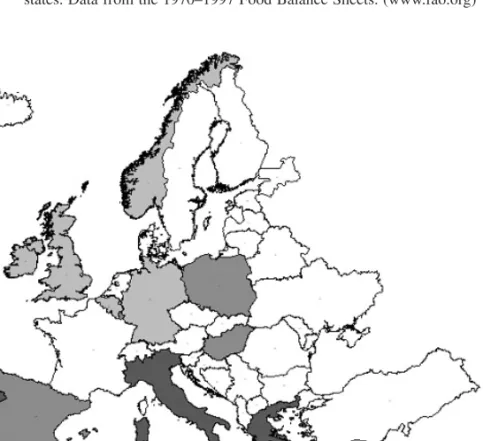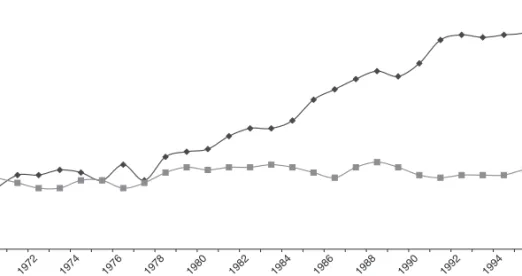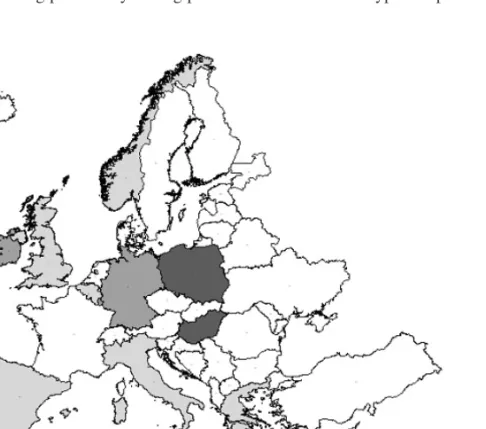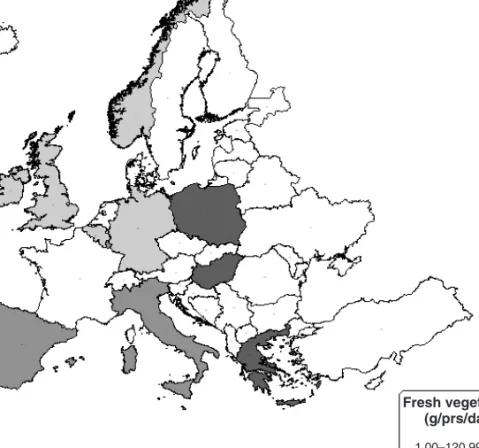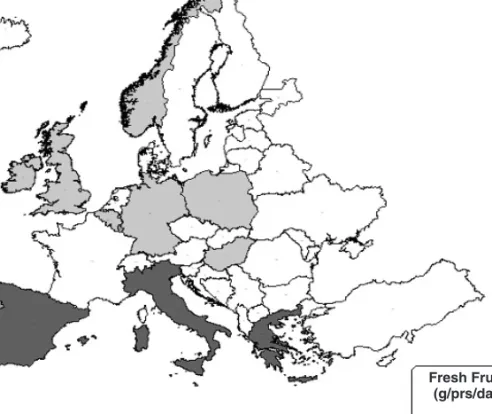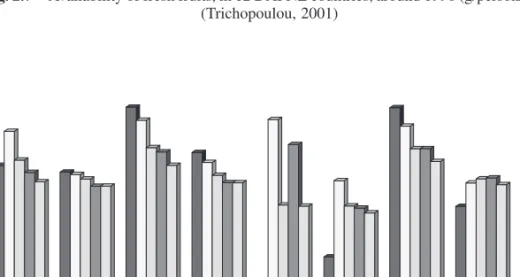The editors of this book have assembled leading experts in the field to provide the food industry with a single authoritative resource. This book first defines and classifies the field of functional foods, with particular attention to the legislative aspects in both the US and EU.
Introduction
Against this background, Chapter 7 discusses the current limitations of the accuracy of nutrition information, both in terms of food composition and the impact of nutrients on health. Against this background of research on nutrients and the way consumers evaluate nutritional quality, much of this guide is devoted to assessing the impact of food processing on key nutrients.
In addition to frying and ohmic heating, there are chapters on continuous flow heat processing (Chapter 22), extraction cooking (Chapter 14), microwave and infrared heating (Chapters 18 and 20).
Nutrition and consumers
What consumers eat
Trichopoulou and Naska, University of Athens
- Introduction
- Dietary components and health
- Sources of dietary data
- Food balance sheets
- Household budget surveys
- Individual dietary surveys
- Dietary data in Europe: national surveys
- Dietary data in Europe: European surveys
- The DAta Food NEtworking (DAFNE) initiative
- The European Prospective Investigation into Cancer and Nutrition (the EPIC study)
- MONItor trends in CArdiovascular diseases (the WHO-MONICA study)
- Nutrition and the elderly in Europe – the Euronut-SENECA study In 1986 the Management Group of the Concerted Action on Nutrition and Health
- International studies to address specific objectives
- Dietary patterns in Europe
- Future trends
- Sources of further information and advice
- References
However, the method to address these discrepancies has been developed in connection with the DAFNE project (Lagiou et al, 2001; Friel et al, 2001). The differences in the data collection method are reflected in the type and accuracy of the data collected.
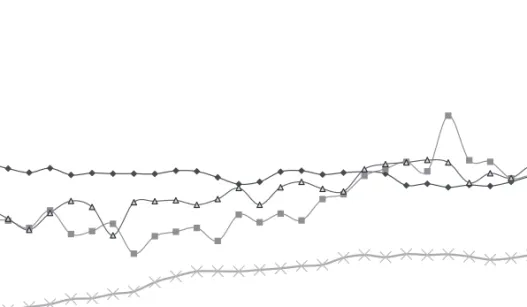
Vitamins
Introduction
- Dietary reference values
The Commission changed the nomenclature of 'requirements' and while most sets of RDAs provided only one value for micronutrients, the new Dietary Reference Values (DRVs) specify three levels of values for each age and gender group. In the UK context, the reason for considering only 9 of the 13 vitamins was that the group felt that only those micronutrients with potential for deficiency needed to be addressed in such detail.
Vitamin A
It was thought that the EAR could be increasingly used in food labeling to provide a common basis for comparison of all nutrients in food, but the RNI is a key value for clinical and health purposes. In addition, there was insufficient information for pantothenic acid, biotin, and vitamins E and K to provide a complete set of recommendation data, so only individual safe intake recommendations were considered (Whitehead, 1992).
Vitamin A deficiency disorders (VADD)
Folate Main sources: liver, dark green leafy vegetables, beans, wheat Helps in protein metabolism; promotes red blood cell formation;. Pantothenic yeast, liver, heart, brain, kidney, eggs, milk, vegetables, Involved in energy production; helps in the formation of hormones.
Bioavailability of provitamin carotenoids
- Relationship between bioefficacy and vitamin A requirements The RNI for children up to 5 years of age is 400 m g retinol equivalents (RE)/day,
- Equivalence factor as calculated by IOM
The basis for the formulation of the equivalence factor was to relate the absorption of b-carotene in a mainly mixed vegetable diet to the absorption from oil in healthy and nutritionally adequate individuals. The recommendations were based on a product of relative absorption of b-carotene in mixed vegetable diet (1 : 6) (van het Hof et al, 1999) to the amount of retinol formed (1 mg) when 2 mg of b-carotene was fed in oil (Sauberlich et al., 1974).
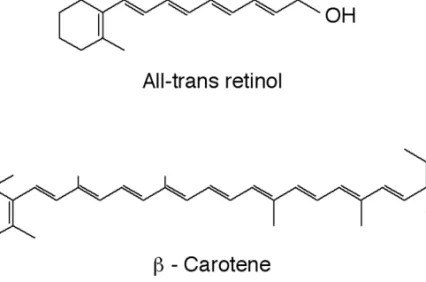
Function
- Vision
- Cell differentiation
- Embryogenesis
- Immunity
One of the first names for vitamin A was the 'anti-infective vitamin', which was based on the increased number of infections observed in animals and humans VAD (Ross, 1996). Therefore, in the presence of VAD, the Th1:Th2 ratio may increase during an immune response.
Health-related roles of b -carotene
- b -Carotene as an antioxidant
- b -Carotene and protection from cancer
- Reasons for increased cancer risk associated with b -carotene supplementation
The enzyme responsible for the conversion of retinol to HRR has not been characterized. c) The third study was the Physicians Health Study, in which 22,071 US male physicians were randomized to receive 50 mg β-carotene or aspirin (325 mg) or both or neither of them every other day for 12 years. Another explanation could be that b-carotene acts as a pro-oxidant in the presence of high oxygen tension in the lungs.
Safety of vitamin A and b -carotene
- Safety of retinol
- Safety of b -carotene
Chronic hypervitaminosis A can be defined as any symptom resulting from sustained intake of high doses of vitamin A over months or years (Blomhoff, 2001). In addition, doses of 180 mg/day have been used for many years to treat patients with erythropoietic protoporphyria without evidence of vitamin A toxicity (Blomhoff, 2001).
Vitamin D
In two studies giving very different large intakes of β-carotene (15 and 40 mg), the mean intake of β-carotene was <2 mg, suggesting that the human gut has only a limited ability to absorb β-carotene (van Vliet et al, 1995; O'Neill and Thurnham, 1998).
Specific nutritional deficiencies
- Asian communities in the UK
- Elderly
- Other diseases linked to vitamin D deficiency
- Vitamin D and type 1 diabetes
Early childhood enterovirus infections and childhood obesity were also associated with increased risk of type 1 diabetes (Hyppönen et al, 2001). Nevertheless, none of the above explains the molecular role in the pathogenesis of type 1 diabetes, and more work is needed in this area.
Synthesis and actions of 1,25-OHD
In response to PTH in the condition of vitamin D deficiency, 1,25-OHD production is high (and this directly causes feedback inhibition of PTH production in the parathyroid gland) and 24,25 OHD production is low. In the vitamin D-adequate state, 1a-hydroxylase activity in the kidney is increased and more 24,25-OHD is produced.
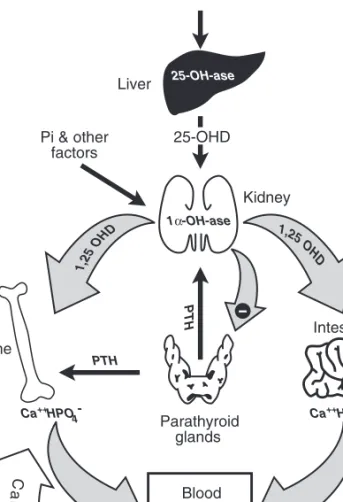
Bone mineral density and fractures
Vitamin D maintains plasma calcium concentrations by stimulating intestinal calcium absorption through the small intestine and/or the resorption of calcium from bone. Serum calcium is tightly controlled, but a number of studies suggest that it peaks in summer, perhaps due to improved vitamin D status, growth stimulation in children, and higher intestinal calcium absorption (McCance and Widdowson, 1943).
Vitamin D and other aspects of health
- Behaviour
- Colon cancer
- The immune system
Safety
Vitamin E
For this reason, plasma tocopherol is usually expressed relative to circulating lipids, and the most commonly used ratio is serum tocopherol:cholesterol. Serum a-tocopherol values of 11.6 mmol/l or an a-tocopherol : cholesterol ratio of 2.2 mmol/mmol indicate a risk of vitamin E deficiency (Thurnham et al, 1986).
Biological activity
Vitamin E status can be measured as plasma tocopherol concentration, but increased concentration of serum lipids appears to cause tocopherol to leave cell membranes and enter the circulation, thereby increasing blood levels.
Coronary heart disease (CHD)
- Randomised trials
Biochemical evidence to support epidemiological data suggests that susceptibility of LDL-cholesterol to oxidative modification to an atherogenic form is essential in the development of atherosclerosis. If LDL is exposed to a copper-mediated oxidation system, vitamin E in the outer phospholipid layer of LDL is depleted first, followed by carotenoids, lycopene, and b-carotene.
Other roles of vitamin E
- Immuno-enhancement
- Vascular effects of vitamin E
- Oxidative damage to DNA and DNA repair
Further research into the possible effects of vitamin E on the clinical aspects of cardiovascular disease is needed. Dose may play a critical role in the effects of vitamin E on immune function and high doses may strengthen the immune system of the elderly by suppressing prostaglandin E2 (PGE2) production and/or reducing free radical formation.
Safety issues
Vitamin K
Biological activity
- Blood clotting
- Bone
The biological relevance of the Gla structure is that it forms a cage structure to which divalent metal ions, such as calcium, can be bound (Berkner, 2000). Osteocalcin is a water-soluble protein of 49 residues and accounts for up to 80% of the total g-carboxyglutamyl content in mature bone (Olson, 1999).
Vitamin K status and health
- Adults
- Infants
- Bone health
- Intervention studies
Arm BMD increased by 2.1% in the vitamin K group but decreased by 2.4% in the vitamin D group (P<0.001); no difference in vertebral BMD was found. A more recent study reported that 45 mg of vitamin K2 or placebo given for 2 years to 241 osteoporotic women increased BMD and significantly reduced the incidence of new fractures (14 in the vitamin K vs. 35 in the placebo group) ( Shiraki et al, 2000).
Safety
They gave either a daily dose of 45 mg vitamin K2alone or vitamin K2plus1mg 1-ahydroxyvitamin D3 or vitamin D alone. Finally, preliminary data from a placebo-controlled, randomized, clinical trial of 244 postmenopausal women aged 60-85 years after a 2-year intervention period showed a significant increase in BMD of the distal radius in a group receiving 200 mg vitamin K1 plus 10 mg vitamin D and 1 g of calcium (Bolton-Smith et al, 2001).
Vitamin C
Absorption and deficiency
Biochemical functions
Disease–nutrient interactions
There are also other groups within industrialized countries where there may be risks associated with increased intake of vitamin C. Fruit and vegetables are associated with a reduced risk of cardiovascular disease and many forms of cancer and neurodegenerative diseases, but the role of vitamin C in this effect is uncertain (Halliwell, 2001).
Immune function
Furthermore, it should be remembered that oxidized vitamin C can be regenerated in erythrocytes and other tissues (Chaudiere and Ferrari-Iliou, 1999), and if the radical scavenging properties of vitamin C are preserved, the regeneration of reduced vitamin C should occur. increased if plasma concentrations are lower. In addition, no conclusive evidence of a protective effect of vitamin C was found in studies on strand breaks, micronuclei or chromosomal abnormalities (Halliwell, 2001).
Toxicity
It has been suggested that plasma AA concentrations of 40–50 mmol/L, from an intake of 50–60 mg/day, are optimal for protection against heart disease (Gey, 1993). However, it is clear that plasma vitamin C is affected by many factors other than diet, and therefore it is difficult to suggest that a particular plasma concentration is optimal for all situations (Thurnham, 2000).
Vitamin B 1 (thiamin)
However, in many parts of the developing world, thiamine is obtained from unrefined cereal grains or starchy roots and tubers. Thiamine is water soluble and is stable in slightly acidic water up to boiling point.
Functions and requirements
- Thiaminase enzymes
Thiamine is unstable in alkaline solution and is therefore lost during the distillation process to produce alcohol. In the British diet, 45% of thiamine is obtained from fortified white flour products (fortified with 2.4 mg thiamine/kg white flour).
Clinical thiamin deficiency
- Beriberi
However, an examination of the published reports of pure thiamine deficiency without accompanying chronic and excessive alcohol consumption shows that in this group of patients the rate of progression to Korsakoff's syndrome is low. It is relatively easy to test for thiamine status using activity levels of the thiamine-dependent enzyme erythrocyte TKL;.
Toxicity
Folate
These factors explain the wide range of folate bioavailability of naturally occurring folate polyglutamates in all foods. Donations of methyl groups from SAM produce S-adenosylhomocysteine (SAH), which is rapidly hydrolyzed to homocysteine.
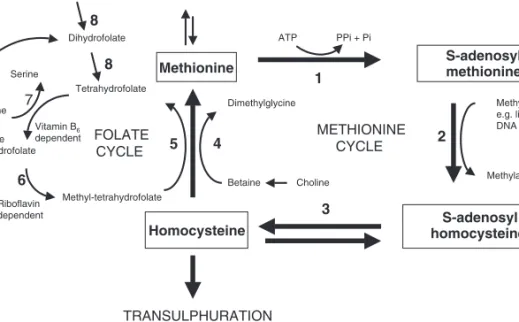
Requirements
- Folate requirements in women
- New recommendations
- Fortification
The MRC trial provided the first clear confirmation of the effectiveness of periconceptional folic acid in the prevention of NTDs (MRC Vitamin 73. Recent published data show that the incidence of NTDs in the US has fallen by almost 20% since the introduction of the fortification policy ( Honein et al, 2001).

Folate, homocysteine and cardiovascular disease (CVD)
This level of fortification is estimated to increase average folic acid intake by 200mg/day, which is predicted to reduce NTD pregnancies by 41%. Homocysteine and folate (serum or red cell) showed no response with any of the doses in the lower tertile.
Causes of decreased folate status
A recent meta-analysis of 12 randomized controlled trials, which included 1114 subjects, showed that folic acid in the range of 0.5-5 mg/day lowered plasma homocysteine by about 25% with 0.5 mg/day so effective than 5 mg/day (Clark and Homocysteine Lowering Trials Collaboration 1998). It was therefore important to investigate whether dietary modification or fortification with lower levels of folic acid could also be effective.
Safety/toxicity
The dose of folate at which any of the above adverse effects may occur is not known, but when calculating safe levels for fortification, 1 mg/d was taken as the upper tolerable intake level to prevent masking of vitamin B12 deficiency in older (McNulty, 2001). Therefore, the proposed fortification level (2.4 mg/kg flour) should provide the extra 200 mg folate/day for both the homocysteine-lowering effects and to reduce the risk of NTDs (see section 3.35) and should not exceed safe levels for intake.
Cobalamin (vitamin B 12 )
In addition, high amounts of folate will mask vitamin B12 deficiency thus allowing the associated neuropathy to develop. High amounts of folate have also been implicated in destabilizing epilepsy, which is being controlled with anticonvulsants, and accelerating the growth of some tumors (Scott, 2000).
Deficiency
The TC defect may be due to TC II being absent, or it may be immunologically normal but not bind cobalamin, or it may bind cobalamin but not be taken up by the cell wall receptor. Several drugs, such as colchicine, neomycin, p-aminosalicylate and alcohol cause vitamin B12 malabsorption (Halsted and McIntyre, 1972).
Assessment and other issues
- Plasma and urinary methylmalonic acid
- Homocysteine
However, plasma MMA concentrations appear to be more specific and sensitive indicators of vitamin B12 status than homocysteine concentrations and are significantly better than plasma vitamin B12. In vitamin B12 deficiency, elevated levels of MMA and homocysteine appear to occur before the decline in plasma vitamin B12 (Green, 1995).
Safety/toxicity
Plasma concentrations of homocysteine increase in deficiency states of folate, vitamin B12 and pyridoxine, in individuals with congenital defects in the enzymes of homocysteine metabolism and in individuals with defects associated with the synthesis of vitamin B12 coenzymes necessary for normal function of methionine synthetase. It is not unknown for normal individuals with normal plasma vitamin B12 concentrations to have had elevated levels of MMA that decreased after a single injection of vitamin B12.
Biotin
Three of the four biotin-dependent carboxylases are mitochondrial: propionyl-CoA carboxylase, methylcrotonyl-CoA carboxylase and pyruvate carboxylase;. Pyruvate carboxylase is a key enzyme in gluconeogenesis, so impairment due to biotin deficiency can lead to fasting hypoglycemia.
Pantothenic acid
Work with chickens showed that fatal hypoglycemia, called "fatty liver and kidney syndrome," was the result of impaired gluconeogenesis caused by deficient pyruvate carboxylase activity. Several workers have suggested that biotin deficiency may cause sudden infant death syndrome (SIDS) by an analogous pathogenic mechanism (Mock, 1999).
Deficiency
- Nutritional melalgia
- Hair colour
- Alzheimer’s disease
Early studies showed a loss of coat color in black and brown rats fed a diet deficient in pantothenic acid; as a result, pantothenate became known as an anti-grey factor. A rare side effect of treatment is hepatic encephalopathy and excretion of various dicarboxylates, both of which are reversed by pantothenate, suggesting that homopantothenate may cause pantothenate deficiency.
Toxicity
Although there is no evidence to support the idea that loss of hair color with age is related to pantothenic acid deficiency, it is still added to shampoos (Bender, 1999).
Niacin
Pellagra is often associated with the "starving season", strong sun and a diet mainly of corn and millet. A dose of 40-200 mg niacin/day can be used to treat symptoms of Hartnup's disease.
Vitamin B 6 (pyridoxine)
It is generally believed that 1 IU is equivalent to 60 mg of tryptophan or 1 mg of dietary niacin. Pellagra is sometimes found in malnourished alcoholic patients and has been found to be associated with the ingestion of mycotoxins from the mold Fusarium.
Deficiency
- Vitamin B 6 and plasma homocysteine
Intestinal absorption takes place mainly in the jejunum by unsaturated, passive diffusion of unphosphorylated forms of the vitamin. The reduced efficiency of vitamin B6-dependent transsulfurization reactions appears to be adequately counteracted by cellular remethylation capacity, and plasma homocysteine steady state is not affected.
Safety/toxicity
This means that plasma homocysteine is much more influenced by folate and vitamin B12 status than by vitamin B6 status (Gregory, 2001).
Riboflavin
Riboflavin coenzymes are required in the Krebs cycle, therefore requirements for riboflavin are often associated with energy requirements. Average dietary intake in the latter individuals corresponded to intakes of 1.3 mg/day for men and 1.1 mg/day for women.
Modulators of multiple hormone signaling pathways', in Vitamin A in Health and Disease, R Blumhoff (ed), New York, Marcel Dekker, 239–55. MRC Vitamin Study Research Group (1991), "Prevention of Neural Tube Defects: Results of the Medical Research Council Vitamin Study", Lancet.
Minerals
Reilly, Oxford Brookes University
- Introduction
- Chemical characteristics
- Impact on health, absorption and recommended intakes
- Dietary sources, supplementation and fortification
- Calcium
- Calcium absorption
- Functions of calcium in the body
- Osteoporosis
- Recommended intakes of calcium
- Dietary sources of calcium
- High intakes of calcium
- Iron
- Iron absorption
- Functions of iron
- Iron deficiency anaemia
- Recommended intakes
- Dietary sources of iron
- High intakes of iron
- Zinc
- Zinc absorption from food
- Functions of zinc in the body
- Zinc requirements and dietary reference values
- Zinc levels in foods and dietary intakes
- High intakes of zinc
- Other minerals: iodine and selenium
- Iodine
- Selenium
- Sources of further information and advice
- References
In the United Kingdom, Reference Nutrient Intakes (RNIs) for 11 minerals have been published by the Department of Health to meet the requirements for different age groups and sexes in the Community (Department of Health, 1991). In the United Kingdom, the COMA (Committee on Medical Aspects of Food Policy) Dietary Reference Values Panel of the Department of Health, noting the difficulty of assessing the adequacy of dietary calcium supply, has established RNIs for calcium for different groups in the population (Department of Health, 1991).
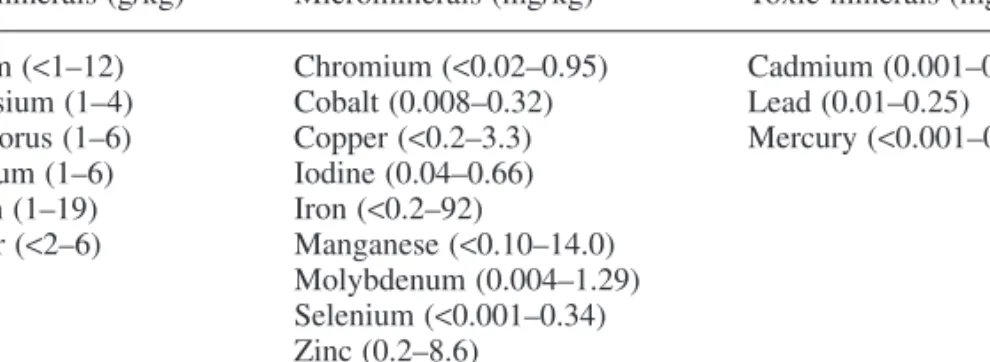
Measuring intake of nutrients and their effects: the case of copper
Introduction
The nutritional role of copper
Found in the adrenal gland and brain, it catalyzes the synthesis of the catecholamines adrenaline and noradrenaline from dopamine. Tyrosinase, or catechol oxidase, is the only enzyme involved in the synthesis of melanin from tyrosine.
Dietary copper requirements
In the nucleus, copper has a structural role as an essential component of chromatin scaffolding proteins, which contributes to nuclear stability.9,10 However, it does not appear to be necessary for DNA synthesis in mammalian cells. Although copper has been identified in yeast cells as a component of gene regulatory mechanisms, it has yet to be identified if equivalent proteins exist in human cells.11.
Sources of copper
Copper deficiency
It has been clearly demonstrated that many of the changes induced by severe copper deficiency are also risk factors for ischemic heart disease in humans. The negative effects of copper deficiency are numerous and as varied as copper's role in health.
Copper toxicity
The issue is currently being studied by several international groups.39 Table 5.3 shows the current permissible levels of copper in drinking water and the recommended limits of total copper intake. A rare inherited disorder of copper metabolism leads to Wilson's disease, in which copper cannot be properly transported from the liver and thus accumulates to toxic levels.
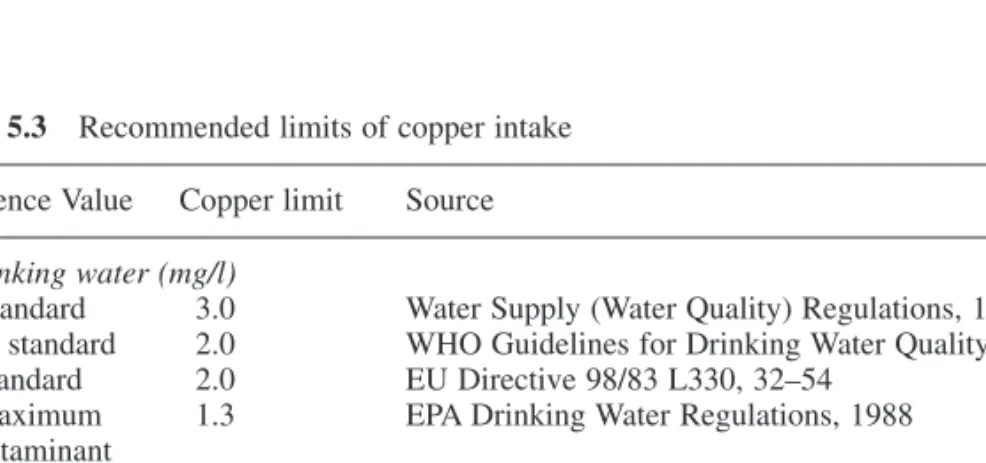
General limitations in assessing nutrient intake
A constant daily intake of the respective nutrient is ensured throughout the study period, and stool and urine collections are also performed. The accuracy of the measurement of intake and excretion is decisive for the success of the investigation.
Putative copper indicators
Traditional reliance on short-term measures for assessing long-term copper status can produce misleading results. DAO has been shown in several studies of copper depletion to be a potential marker of copper status.58 Its measurement is currently difficult due to extremely low plasma levels.
Functional copper status
Mechanisms of copper absorption
Copper absorption in the intestinal mucosa is strongly influenced by chelation of copper ions by amino acids. The high bioavailability of copper in breast milk compared to cow's milk may be a consequence of the protein and amino acid content of the two foods.
Copper distribution in the body
Assessment of copper absorption
Assay, electron ionization mass spectrometry and gas chromatography mass spectrometry offer relatively poor precision, while thermal ionization mass spectrometry is demanding and slow. Monitoring the radioisotope in stool for more than five days would require more than the maximum safe dose106, so endogenous excretion should be determined on a separate occasion using an intravenous dose.
Current research and future trends
Good correlations between blood pressure response and caeruloplasmin concentration were found in individual subjects, suggesting a link between biochemical and physiological indices of copper status. The use of performance-related indices in parallel with biochemical measurements enables the evaluation of potential new indicators of copper status.
Sources of further information and advice
There also seems to be reason to revise the existing guidelines for copper in drinking water. Food Commission: http://www.europa.eu.int/comm/food/index_en.html UK Food Standards Agency: http://www.food.gov.uk/.
24 spiegel j eand willenbucher r f (1999), 'Rapid development of severe copper deficiency in a patient with Crohn's disease receiving parenteral nutrition', Journal of Parenteral and Enteral Nutrition. 25 fuhrman m p, herrmann v, masidonski pand eby c(2000), 'Pancytopenia after removal of copper from total parenteral nutrition', Journal of parenteral and enteral nutrition.
Consumers and nutrition labelling
Insall, Food and Drink Federation, London
- Introduction: the problem of providing nutrition information
- Current EU nutrition information
- Provisions of the current legislation: format
- Calculation of energy value
- Definitions
- Declared values
- Nutrition claims
- Timescale
- Implementation
- General requirements
- Consumer expectations and understanding of nutrition labellingnutrition labelling
- The use of nutrition panels
- Improved nutrition labelling
- Future trends
- Sources of further information and advice
- References
UK implementation of the Nutrition Labeling Directive is through the Food Labeling Regulations 1996 (as amended). Respondents most often used nutritional information to compare two brands of the same product (49% of those who looked at labels said so).
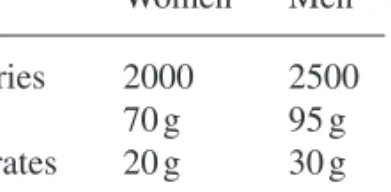
New approaches to providing nutritional information
Introduction
Why food processors need new types of nutritional informationnutritional information
- Showing effects of food properties on nutritional qualities
- Tracking changes in nutritional quality
- Avoiding unjustified extrapolation between products
- Helping consumers choose foods for health
- Gaining consumer confidence
Due to the cost, time, ethics, compliance and other issues involved in clinical trials, human subjects are usually not suitable for monitoring the effects of processing until potential products are identified. In Vitro Prediction of Gut Responses Can give an indication of the effects of digestive conditions.
Limitations of food composition data in food processing
- People eating foods are complex systems consuming complex systems
- Analytical data may not reflect bioactivity 20
- Availability or extraction in analytical systems may not equate with bioavailability 23
- Physiological effects of food constituents depend on prior physiological state
- A single analytical value may represent a group of compounds differing in nutritional properties
- Food matrix properties may strongly modulate nutritional effects 35 Food processing may give products of the same composition, with markedly
Most samples are comminuted to facilitate complete extraction with an effective solvent.24 As a result, food components can be much more soluble during food analysis than during intestinal digestion. For example, digestion in a porous starch-protein matrix in the form of bread occurs much faster than in a solid, non-porous matrix of similar composition, in the form of pasta or whole grains, which therefore has less effect. on blood sugar levels.36,37.
Foundations for practical nutritional information
- End-points that are important to well-being
- Biomarkers that are relevant 38
- Validity that is balanced with practicality
- Nutrition information that is up-to-date
- Relevant indices that are based on factors that confer relevance on food data
- Food data that is easily understood
Instead, intermediate biomarker 'endpoints', markers of exposure to a food component and food properties that research has already established as causes of disease and health, should be used to assess health effects of food processing. Validation is a crucial step in the selection of variables that indicate effects of foods and food processes on biochemical precursors of health endpoints.
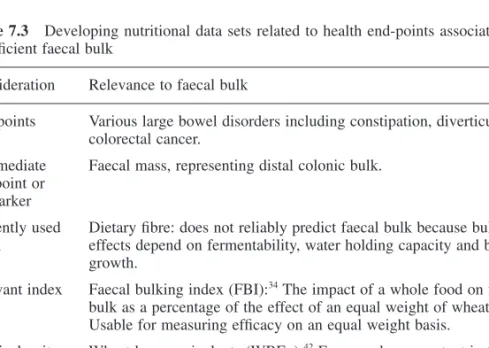
Limitations of food composition data: the case of carbohydratescarbohydrates
- Limitations of carbohydrate composition data
Food data is not relevant if it cannot accurately link consumer behavior to health endpoints, in other words, if it cannot guide food choices for health. Postprandial glycemia and distal colonic bulk are both physiological markers that are strongly influenced by the effects of food properties on carbohydrate availability, but cannot be reliably predicted from food composition data.
Relative glycaemic potency and glycaemic-glucose equivalentsequivalents
- End-point
- Markers
- Current indices
- Relevant indices
- Practical units
- Validity of GGE intake in predicting glycaemic response
- Product screening for GGE content
The glycemic index was created to take into account the relative differences in the effect of dietary carbohydrates on blood glucose resulting from the types of carbohydrates and their rate of digestion.43. Two intrinsic characteristics of the GI make it difficult to use alone in accurate blood glucose management.
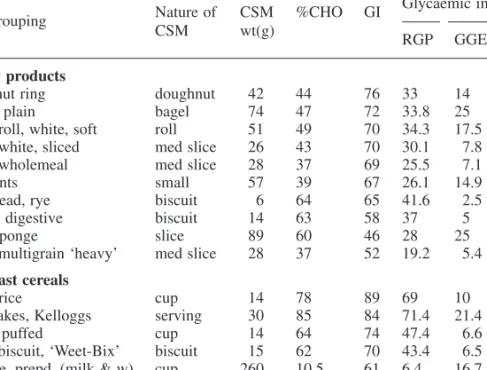
Faecal bulking index and wheat bran equivalents
- End-points
- Markers
- Current indices
- Relevant indices
- Valid measurement
- Practical units
- Application of FBI assay to product screening
Faecal bulking efficiency, as wheat bran equivalents per serving, was classified according to associated nutritional claims for dietary fiber. It was concluded that nutritional claims for dietary fiber in most breakfast cereals probably exaggerate their fecal bulking effectiveness, although the findings would be best confirmed in human trials with some selections of the cereal.
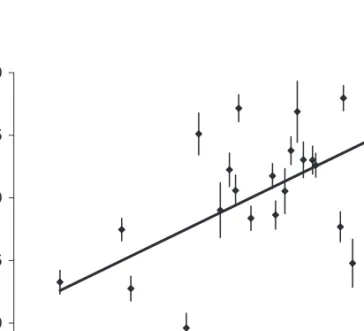
Conclusion and future trends
